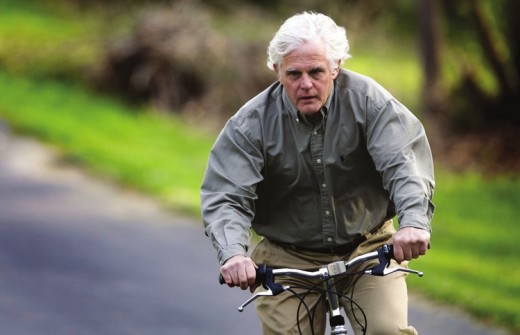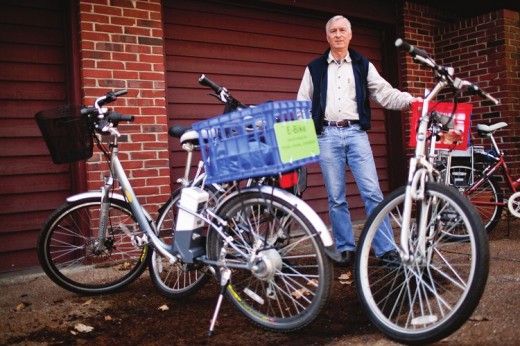No Sweat: Ted Curtis promotes electric bikes for commuters who want some extra pedal power for Columbia’s hills

“My driveway is certainly the worst hill of my commute,” Riddick, 61, said.
But by pushing a red button on his handlebar, Riddick activates the peddle-assist mode on his Currie eZip Trailz bike. As he pedals, the electric motor mounted on his rear hub kicks in a boost of power and propels him up the hill with nary a bead of perspiration on his brow.
“I don’t want to be hot and sweaty when I get to the office,” said Riddick, president of ASI, a flexible spending account administrator located on Broadway across from the public library. “And Columbia has some big hills. My electric bike helps level that out.”
That’s music to the ears of Ted Curtis, who manages Columbia’s biking programs and administers the city’s $22 million federal PedNet grant. Curtis is also in charge of developing multi-purpose trails, walkways, bike lanes and bike routes to entice people out of their cars to lead healthier, more active lifestyles. Biking, he said, offers a quick route to better health, but some Columbia residents have been slow to hop on the saddle.
To learn why, Curtis had two professional surveys conducted and asked people their reasons for not biking. Topping the list were concerns over lacking physical ability and extra travel times precipitated by biking.
“I thought that if it’s an ability factor and a time factor, then maybe electric-assist bikes might fit the notch for some people to get them out and overcome those barriers,” Curtis said.
So he began purchasing low-end electric bikes for around $500 a piece from eBay. By fixing the bikes, reselling them to people such as Riddick and lending demo models to local bike shops, Curtis found he could sprinkle the e-bikes throughout the community. He hopes doing so will generate buzz, turn a few heads and motivate people to at least take the bikes for a test ride.
“It’s hard to set aside federal grant money, so I’ve been doing it pretty much as a hobby — a personal interest type of thing as far as the electric bikes,” Curtis said. “Although from a job standpoint, I can promote the idea, but as far as buying the bikes, I’ve just been buying them out of my own pocket. The model we’re setting up is the e-bikes aren’t really there for purchase. They’re there for demonstration purposes. We’re recommending people go try them out, see what they like and work with the bike shops.”

Campaigning door-to-door, by bike
Fred Schmidt, who was elected to represent the 1st Ward City Council seat in April, relied on his lithium-ion-powered Schwinn to travel between events during his campaign.
“During the election I needed to get places fast because I was really tight on time,” Schmidt said. “If I’m in a hurry, and I have to get all the way down on Chapel Hill Road, I really start to notice the time difference with my e-bike. If I need to get some place far outside of town, it’s really convenient to have it.”
As treasurer of the Missouri Bicycle Federation and an active member of Columbia’s PedNet organization, Schmidt was a little suspicious of Curtis’ e-bike initiative.
“Ted’s really been pushing them, and I was not entirely convinced at first because the whole point of bike riding is to push the pedals,” Schmidt said. “He lent me a Currie, and the second I hit the throttle, I was hooked. They’re a blast.
Schmidt is adamant about getting more Columbia residents to rely less on their cars, and he sees e-bikes as a potential gateway to a more active and ecological lifestyle.
“I was originally skeptical, but I’ve really bought into Ted’s idea of the electric bike being a bridge between the car and the bike,” he said. “There are all sorts of reasons people should be active: overall health, weight loss, and what the Centers for Disease Control has really been pushing in the last few years is chronic disease prevention. People who are inactive are the ones that develop the type-two diabetes and obesity. For someone who may not have the stamina for a five-mile commute, e-bikes could help.”
Schmidt also espoused the political advantages of bike riding.
“You have all these social advantages on a bike,” he said. “When I ride my bike, I’m out in the neighborhood I pass through. I don’t just wave through a glass window. I can stop and talk to people. I’ve picked up clients that way. And as a council person, it’s certainly a good idea to stop and talk to constituents.”
Like John Riddick, Schmidt enjoys arriving to work not looking like he just stepped out of a sauna.
“If I need to go to an event in a suit and tie on a summer day, I can ride my e-bike and arrive not at all sweaty,” Schmidt said. “The Schwinn actually makes me feel like Lance Armstrong because I peddle, and I can achieve racing bike speeds with minimal effort.”
Lawrence Simonson, program assistant for Columbia’s PedNet coalition, said he’s noticed an increase in e-bikes on the streets of Columbia.
“I’ve definitely seen more electric bikes over the last two years,” he said. “They give people more options for modes of transportation, especially if that individual has a low fitness level.”
Despite efforts by cycling advocates to promote e-bikes, some hardcore bike commuters wrinkle their brow at going electric.
Take Don Harter, for example. He commutes 2.7 miles five days a week, rain or shine, to his job at the University of Missouri’s power plant on his vintage 1985 Trek 850 he bought off a Methodist minister.
Clad in a Day-Glo orange reflective vest and gold helmet, Harter interrupted his evening commute to comment about electric bikes.
Whipping raindrops off his glasses, he said, “I could see why e-bikes might be kind of nice with all these hills, especially for people less fit.”
Although intrigued by e-bikes, Harter said he doesn’t see himself taking the plunge just yet.
“Gas is expensive, parking rates are going up, so these electric bikes are an interesting concept,” he said. “But they’re expensive, and besides, this one’s just fine.”
Columbia resident Donna Strickland said she doesn’t bike to work. The 46-year-old said driving is more convenient, and she doesn’t like the idea of showing up to work tired and sweaty.
Despite being tempted by the e-bike’s promise of an easier commute, she still doesn’t see herself taking one for a test ride.
“If I’m going to ride a bike,” she said, “I think I’d just ride a regular bike.”
E-bike buyer’s guide
Like shopping for a regular bicycle, there are a wide variety of options to choose from when considering an e-bike, such as electric control systems, battery types and frame styles.
Currie Technologies, the largest manufacturer of electric-assist bikes in the country, has 23 models available, including those designed primarily for trails, one with a step-through frame (a.k.a. a girl’s bike) and one that folds. Low-end models, such as Currie’s $500 entry-level workhorse cruiser, the eZip Trailz, can often be found online for less than $400. A high-end model, such as Giant’s European-style upright, can set customers back $2,250.
“You’re really buying two things: a bicycle and an electrical system,” Curtis said. “You can try out any bicycle and get sense of what kind of bike you’re getting, but to get a sense of the electrical system, you really need to try a bike with an electrical system on it.”
The demo e-bikes available at Cyclextrem, Walt’s and Tryathletics are all equipped with similar handlebar-controlled electrical systems. The twist throttle control requires no peddling. Riders simply twist the handlebar and accelerate much like if one were on a motorcycle or scooter. In the pedal-assist mode, the motor kicks in only after riders begin pedaling. Some e-bikes, such as Riddick’s eZip, have a combination of both systems. Regardless, all e-bikes have a power cutoff mechanism when the brake is applied.
Most U.S. e-bikes have a motor inside the rear wheel hub. Normal e-bike motors generate about 250 watts of power, strong enough for the bike to hit 15 to 20 mph, but some top shelf motors pump out 500 watts.
What separates high-end from low-end e-bikes are the batteries. Entry-level bikes are commonly equipped with heavy sealed lead acid batteries on the bike’s rear rack and cause bikes to tip the scales at 70 pounds. The cheaper SLA batteries have a lifespan of 200 to 330 full discharges, and replacement packs cost around $100.
High-end models boast lithium-ion batteries with a lifespan of 800 to 1,000 full-discharge cycles and are sometimes housed inside the bike’s front frame. Although the lithium-based batteries are more expensive — often $500 or more per bike — they can reduce a bike’s weight by approximately 30 pounds.
Each e-bike comes with a charger that can be plugged into a wall outlet. Depending on the model, charging time varies from an hour or two up to six or seven hours for some models. Lithium-based battery packs can last more than three years, and SLA’s typically last one to two years. For optimal battery performance, it’s recommended to charge batteries after each use.
Most e-bike batteries can get riders 15 miles or farther on flat ground with some light pedaling. Factor in hills and light pedaling with added power boost, and riders can comfortably expect to complete a 10-mile trip.


